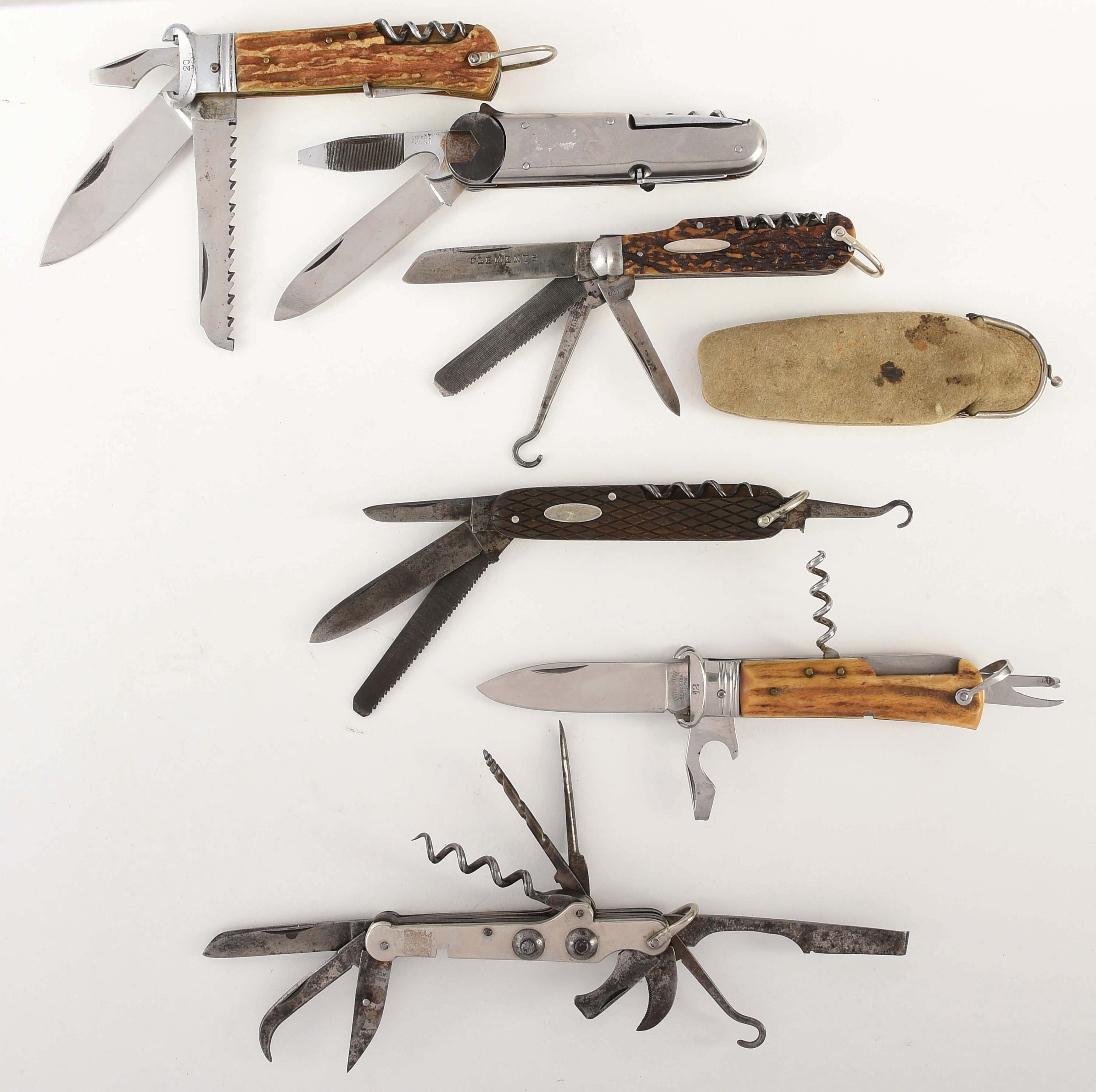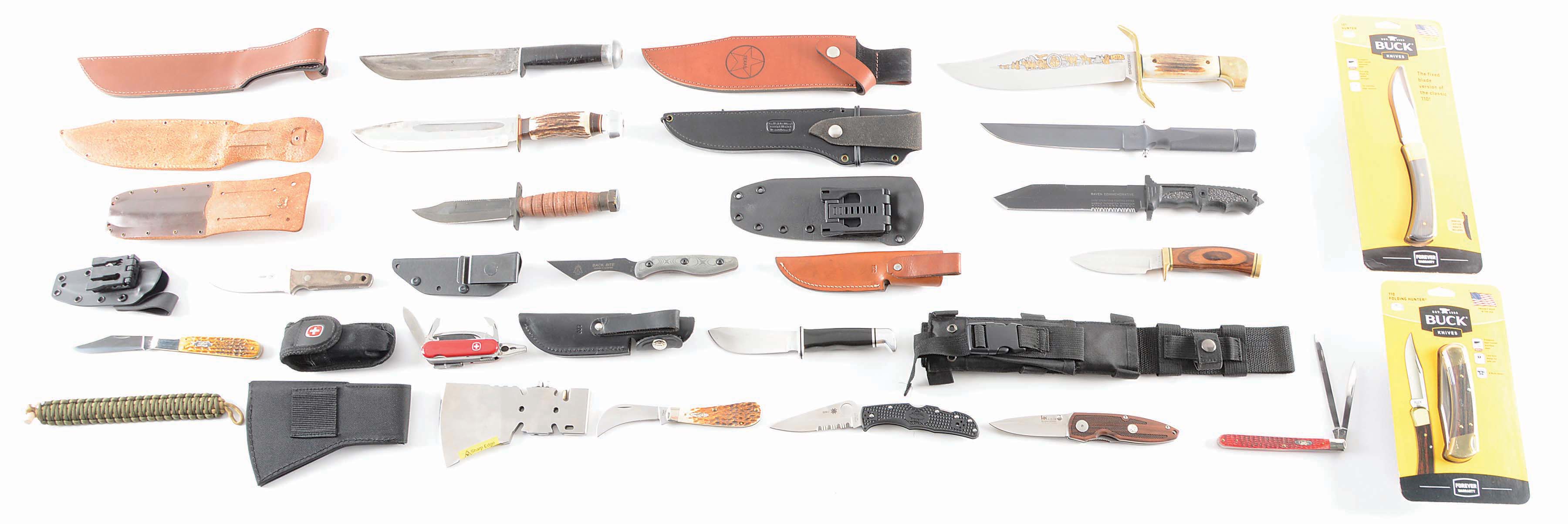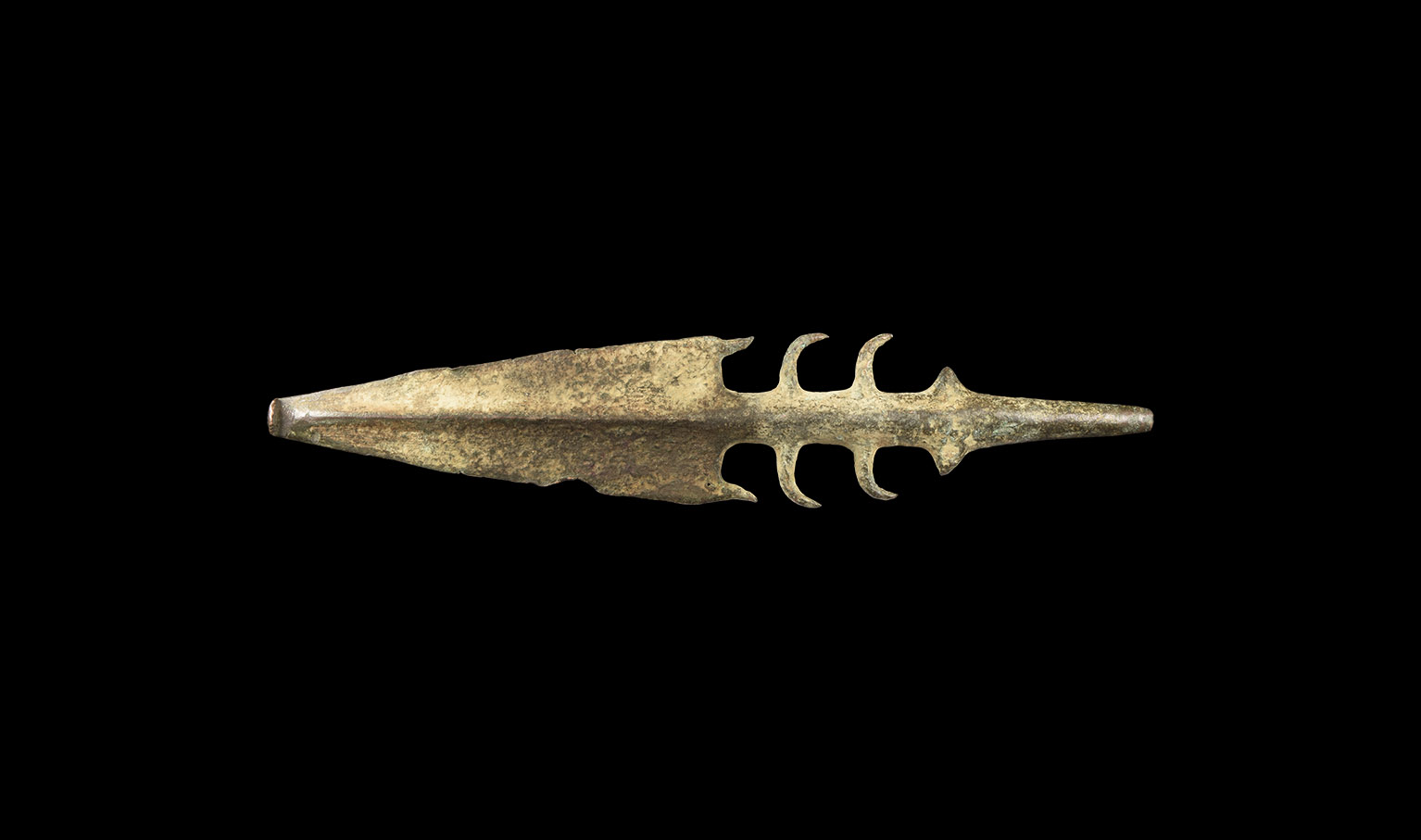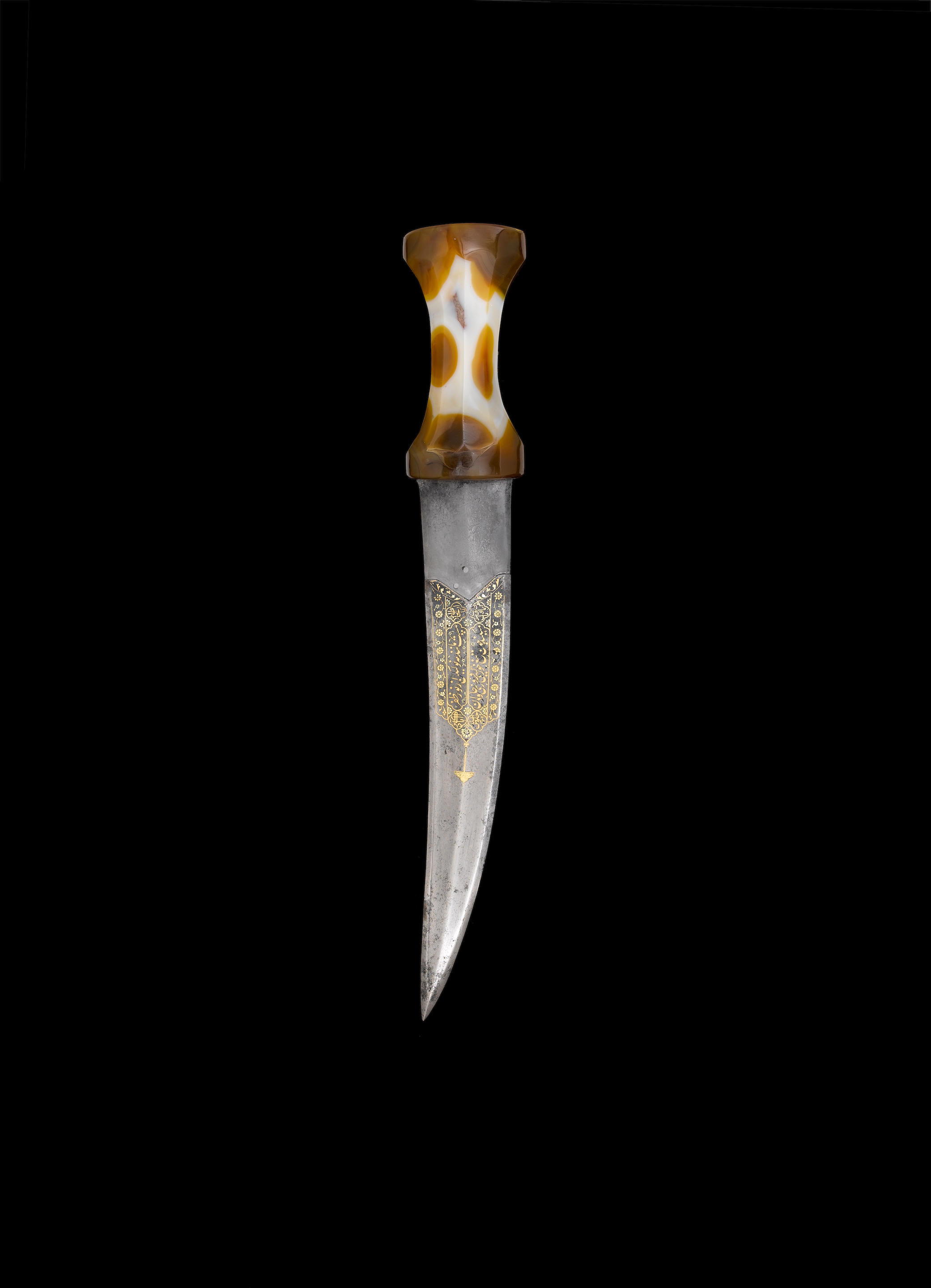with over forty-eight folding blades and accessories, including saws, picks, scissors and corkscrew, some stamped ?George Wostenholm I.XL.?, fitted at each side with highly figured composition scales each retained by four minute screws, with sliding tweezers and picks top and bottom, and in fine condition throughout, 12.0 cm (closed) Literature David Hayden-Wright, The Heritage of English Knives, Atglen, Pennsylvania, 2008, p. 73. It is likely that the founder of George Wostenholm & Son Ltd was George Wolstenholme (1775-1833), a fork maker at Thomas Lane. Apprenticed to John Micklethwaite, a cutler, in 1790 and granted his Freedom in 1799, George later moved to Broad Lane where he made spring knives. He was first listed in a Sheffield directory in 1816 as a pen and pocket knife manufacturer at Rockingham Street, where he had registered a silver mark in 1809. His workshops expanded to become Rockingham Works and he apparently shortened his name to ?Wostenholm? to facilitate its stamping on blades. His son, George Wostenholm (1802-1876) was apprenticed to his father and they are described in 1825 as ?George Wolstenholme & Son, manufacturers of table knives, and forks, pen, pocket, and sportsman?s knives, and general dealers in cutlery, 78 Rockingham Street?. George Wostenholm became a Freeman in 1826, a practical cutler and a dynamic salesman he found scope for his prodigious energy in America where, in 1830, the father and son launched a partnership with William Stenton, an experienced cutlery merchant. However, this did not last and the partnership was dissolved the following year when they were also granted their trademark ?I*XL. ?, bought by George Senior in 1826 and originally granted to William Aldam Smith in 1787. In 1833 George Senior died and the business continued under his son who opened a New York office in 1844, and by the middle of the century had agents in Philadelphia and Boston. America was the ideal market with its expanding frontier and enormous demand for folding knives, razors, and weapons. The firm?s trade became almost exclusively American and Wostenholm made little attempt to nurture other markets. In 1848 the Washington Works was acquired and American orders continued to roll in. The workforce increased significantly to 850 in 1861, having been around a hundred or so in the 1830s. The high quality of the firm?s Bowie and spring knives was achieved by ?drilling?, in which every knife was critically examined. It had the desired effect and soon ?I*XL? vied with Rodgers? star and Maltese cross as a badge of quality. Like Rodgers, Wostenholm made its share of exhibition pieces. At the Great Exhibition in 1851 Wostenholm displayed a set of ornate sheath knives, including one commissioned from the well-known artist Alfred Stevens The company also displayed a collection of exhibition multi-blades. The display won a Prize Medal for Wostenholm. The firm also carried off prize medals at exhibitions in Paris (1855) and London (1862). George Wostenholm had remarkable stamina. In early 1869, in his late sixties, he set off for a tour of Europe and in October the same year he made another trip to New York. In 1872, he again visited New York. He was active until the end, though he sold out to his business associates in 1875, when Wostenholm?s became a limited liability company. George Wostenholm died in 1876, aged 74 and left a remarkable fortune of nearly ?250,000. The new company chairman and directors had little or no experience of the cutlery trade. Initially, Wostenholm?s continued to make good profit but the McKinley Tariff of 1890 raised the duties on their American exports to unprecedented heights and caused a crisis. Wostenholm?s refused to abandon the American trade and maintained an unprofitable New York office open until the early 1930s while they had little success breaking into the Australian and other markets. In the early 20th century they opposed machine technology and consequently w
with over forty-eight folding blades and accessories, including saws, picks, scissors and corkscrew, some stamped ?George Wostenholm I.XL.?, fitted at each side with highly figured composition scales each retained by four minute screws, with sliding tweezers and picks top and bottom, and in fine condition throughout, 12.0 cm (closed) Literature David Hayden-Wright, The Heritage of English Knives, Atglen, Pennsylvania, 2008, p. 73. It is likely that the founder of George Wostenholm & Son Ltd was George Wolstenholme (1775-1833), a fork maker at Thomas Lane. Apprenticed to John Micklethwaite, a cutler, in 1790 and granted his Freedom in 1799, George later moved to Broad Lane where he made spring knives. He was first listed in a Sheffield directory in 1816 as a pen and pocket knife manufacturer at Rockingham Street, where he had registered a silver mark in 1809. His workshops expanded to become Rockingham Works and he apparently shortened his name to ?Wostenholm? to facilitate its stamping on blades. His son, George Wostenholm (1802-1876) was apprenticed to his father and they are described in 1825 as ?George Wolstenholme & Son, manufacturers of table knives, and forks, pen, pocket, and sportsman?s knives, and general dealers in cutlery, 78 Rockingham Street?. George Wostenholm became a Freeman in 1826, a practical cutler and a dynamic salesman he found scope for his prodigious energy in America where, in 1830, the father and son launched a partnership with William Stenton, an experienced cutlery merchant. However, this did not last and the partnership was dissolved the following year when they were also granted their trademark ?I*XL. ?, bought by George Senior in 1826 and originally granted to William Aldam Smith in 1787. In 1833 George Senior died and the business continued under his son who opened a New York office in 1844, and by the middle of the century had agents in Philadelphia and Boston. America was the ideal market with its expanding frontier and enormous demand for folding knives, razors, and weapons. The firm?s trade became almost exclusively American and Wostenholm made little attempt to nurture other markets. In 1848 the Washington Works was acquired and American orders continued to roll in. The workforce increased significantly to 850 in 1861, having been around a hundred or so in the 1830s. The high quality of the firm?s Bowie and spring knives was achieved by ?drilling?, in which every knife was critically examined. It had the desired effect and soon ?I*XL? vied with Rodgers? star and Maltese cross as a badge of quality. Like Rodgers, Wostenholm made its share of exhibition pieces. At the Great Exhibition in 1851 Wostenholm displayed a set of ornate sheath knives, including one commissioned from the well-known artist Alfred Stevens The company also displayed a collection of exhibition multi-blades. The display won a Prize Medal for Wostenholm. The firm also carried off prize medals at exhibitions in Paris (1855) and London (1862). George Wostenholm had remarkable stamina. In early 1869, in his late sixties, he set off for a tour of Europe and in October the same year he made another trip to New York. In 1872, he again visited New York. He was active until the end, though he sold out to his business associates in 1875, when Wostenholm?s became a limited liability company. George Wostenholm died in 1876, aged 74 and left a remarkable fortune of nearly ?250,000. The new company chairman and directors had little or no experience of the cutlery trade. Initially, Wostenholm?s continued to make good profit but the McKinley Tariff of 1890 raised the duties on their American exports to unprecedented heights and caused a crisis. Wostenholm?s refused to abandon the American trade and maintained an unprofitable New York office open until the early 1930s while they had little success breaking into the Australian and other markets. In the early 20th century they opposed machine technology and consequently w



.jpg)











Try LotSearch and its premium features for 7 days - without any costs!
Be notified automatically about new items in upcoming auctions.
Create an alert